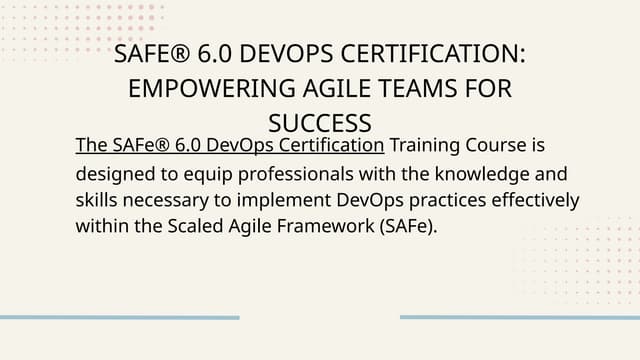Leading SAFe for Executives: Why It's Important for Venture Success
Leading SAFe for Executives: Why It's Important for Venture Success
Blog Article
Master Agile Practices Via Comprehensive SAFe Qualification
In a progressively complicated organization landscape, mastering Nimble techniques through detailed SAFe accreditation has actually emerged as an essential competency for experts aiming to improve business efficiency. As organizations seek to navigate the difficulties of rapid change, the application of SAFe concepts supplies a path to enhanced end results.
Recognizing SAFe Structure
The SAFe (Scaled Agile Framework) framework functions as an organized approach for carrying out Agile practices at scale across big companies. It provides an extensive method that lines up the numerous degrees of an organization, from team to portfolio, making sure that all components function cohesively in the direction of usual objectives. SAFe integrates principles from Agile, Lean, and product development flow, providing a distinct collection of roles, practices, and obligations.
At its core, the SAFe framework comprises 4 levels: Team, Program, Large Service, and Profile. Each degree addresses certain elements of Nimble delivery, from managing little teams of developers to overseeing numerous programs and lining up calculated efforts with organization goals.
SAFe motivates collaboration amongst cross-functional groups, promoting a setting where continuous renovation and innovation are paramount. SAFe Lean Portfolio Management. By highlighting alignment, openness, and built-in quality, the structure gears up organizations to react swiftly to market adjustments while providing worth to customers
Additionally, SAFe supports numerous approaches, such as Scrum and Kanban, permitting organizations to customize their technique according to specific task demands. This adaptability ensures a robust structure for organizations intending to thrive in a rapidly advancing company landscape.

Advantages of SAFe Qualification
Frequently searched for in the Agile neighborhood, SAFe qualification offers various benefits for specialists and companies alike. One of the main advantages is the improvement of abilities and knowledge in carrying out the Scaled Agile Structure (SAFe), which outfits people with the devices necessary to drive successful Agile changes. This accreditation indicates a commitment to expert development, making candidates more competitive in the work market.
For companies, having certified professionals fosters a culture of continuous improvement and cooperation, crucial for adjusting to altering market demands. It allows teams to align their work with strategic goals, inevitably boosting performance and effectiveness. Business with a higher proportion of SAFe-certified employees frequently experience reduced time-to-market and increased top quality of deliverables.
In addition, SAFe accreditation assists in networking chances with other Agile practitioners, making it possible for the exchange of ideal methods and experiences (SAFe Lean Portfolio Management). This collective network can considerably add to individual and organizational development. In summary, obtaining SAFe qualification not only enhances individual capacities however likewise reinforces the general Agile maturity of a company, resulting in lasting success in today's dynamic business setting
Key Elements of SAFe
Building on the benefits of SAFe accreditation, comprehending the key elements of the Scaled Agile Framework is click now crucial for efficiently applying its principles. The SAFe structure comprises 4 primary levels: Group, Program, Large Remedy, and Portfolio. Each degree addresses various elements of dexterous practices, promoting positioning and distribution throughout the organization.
At the Group degree, cross-functional groups work collaboratively utilizing Agile approaches, such as Scrum or Kanban, to supply incremental value (SAFe For Architects). The Program degree focuses on the Agile Release Train (ART), which is a long-lived team of Agile groups that prepares, devotes, and implements together. The Huge Service level addresses intricate solutions that need several ARTs to operate in show, ensuring coordination and combination

Planning For SAFe Qualification
Planning for SAFe qualification needs a calculated technique to make sure a detailed understanding of the framework. Acquaint on your own with the core concepts and values of the Scaled Agile Framework (SAFe) Testimonial sources supplied on the Scaled Agile site, including the SAFe structure documents, situation research studies, and whitepapers, to build a strong structure.

Additionally, method with example exam questions to familiarize on your own with the format and kinds of inquiries you might experience. Joining study hall or discussion forums can help with understanding exchange and give support from fellow candidates.
Using SAFe in Organizations
Applying the Scaled Agile Framework (SAFe) within companies demands a structured method that lines up groups and procedures towards a common goal. The successful application of SAFe begins with establishing a clear understanding of its concepts, consisting of partnership, transparency, and positioning. Organizations needs to first examine their present processes and identify areas for enhancement, guaranteeing they are all set for the social shift that SAFe requires.
Next, management dedication is important. Management has to proactively support the shift by promoting a society website link of continual important site discovering and versatility. Training and accreditation for groups assist gear up members with the necessary abilities and expertise to run successfully within the SAFe structure. This includes establishing Agile Launch Trains (ARTs), which function as the foundation for supplying value across the company.
Normal planning sessions, such as Program Increment (PI) preparation, must be carried out to integrate teams and focus on work. Additionally, leveraging metrics to gauge development and performance is essential for recurring enhancement. By regularly using SAFe principles and techniques, organizations can accomplish greater dexterity, enhance collaboration, and inevitably drive better organization outcomes. Embracing this structure positions organizations to react promptly to market changes and client demands.
Verdict
Finally, understanding Dexterous techniques through extensive SAFe accreditation significantly enhances professional capacities and contributes to organizational effectiveness. The understanding acquired from understanding the SAFe framework, together with its key elements, enhances and promotes effective improvements cooperation among groups. Furthermore, getting this certification settings individuals favorably in an affordable work market, emphasizing the value of constant improvement and positioning within companies. Accepting SAFe ultimately results in increased performance and greater quality deliverables.
The SAFe (Scaled Agile Structure) structure serves as an organized approach for carrying out Agile methods at range throughout huge organizations. One of the main advantages is the improvement of skills and expertise in executing the Scaled Agile Structure (SAFe), which equips individuals with the devices essential to drive successful Agile improvements. In summary, acquiring SAFe qualification not just boosts individual abilities yet also strengthens the general Agile maturation of a company, leading to sustainable success in today's dynamic service setting.
Structure on the advantages of SAFe accreditation, recognizing the key components of the Scaled Agile Framework is important for effectively implementing its principles.Carrying Out the Scaled Agile Structure (SAFe) within companies requires an organized technique that aligns teams and procedures towards a common goal.
Report this page